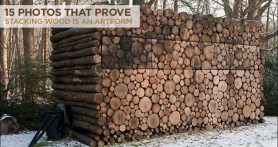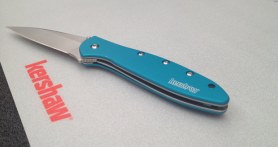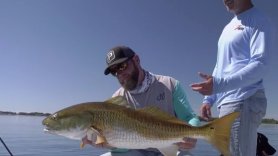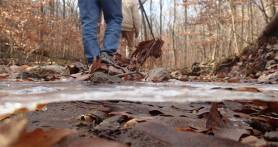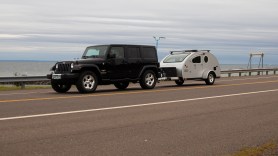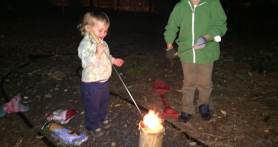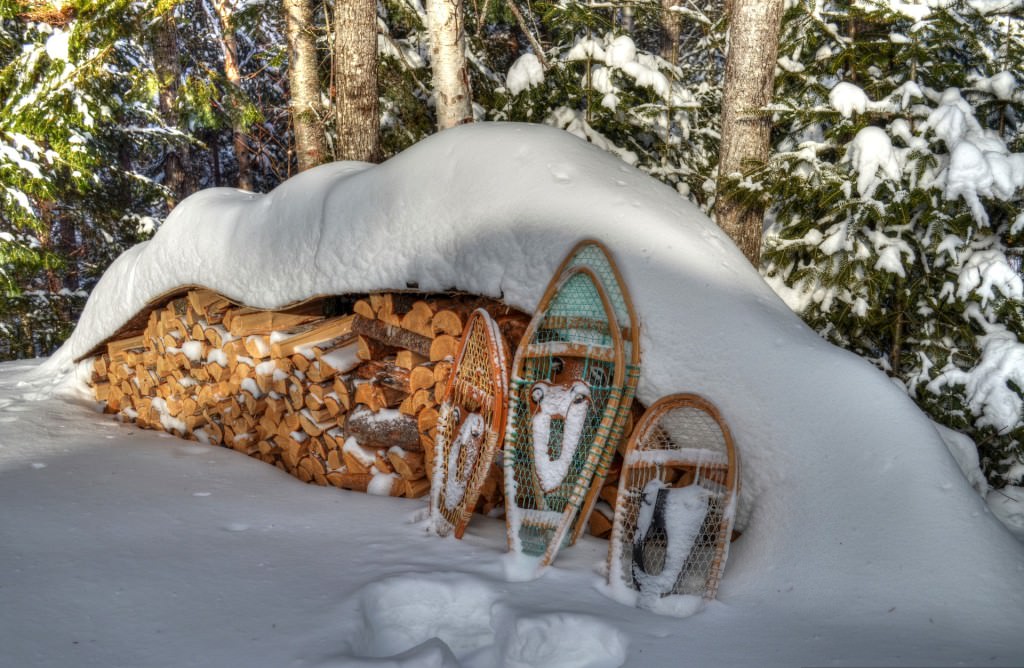

What’s better than taking a hike in the cool crisp air after a good snowfall? If you are looking for a way to introduce a whole family to winter snow sports then snowshoeing should appeal to you. One of the most appealing parts of snowshoeing for families is the relatively inexpensive gear in contrast to snowboarding or skiing, which need specialized footwear and a much higher skill level than snowshoeing. Skiing, snowboarding and other snow sports require a lot of time to master certain techniques and balance, but snowshoeing is just learning to walk with wider soles on your shoes. If you want a fun recreational activity that’s easy to pick up and take your kids with you, try snowshoeing this winter!
Videos by Outdoors with Bear Grylls
Size:
The most important thing to remember when buying a pair of snowshoes is that it’s all about the fit. Snowshoes use their width to keep your weight evenly distributed across the surface of the snow, and the more you weigh – with the gear you’ll be carrying – the wider and longer your snowshoes need to be in order to keep you from sinking. Also, think about what activities you’ll be doing while snowshoeing; if you need more mobility, a smaller size may help keep you agile when plowing through powder. Typically, snowshoes are available in lengths ranging from 20” to 36”, and usually get wider as they get longer. We always recommend asking the salesperson from whom you’re buying your snowshoes for size recommendations, but these guides are a good rule of thumb:
- 100 to 140 lbs: 20” to 22”
- 140 to 180 lbs: 24” to 25”
- 180 to 220 lbs: 30”
- 220 to 260 lbs: 35” to 36”
Type:
Most first-time snowshoers are going to be interested in recreational snowshoes, with beginner- friendly bindings and fit, but other types are also available for those interested in different activities. Backcountry snowshoes offer higher durability and lower weight, and generally feature stronger bindings and tougher crampons. Generally sporting a rounded tail for those looking to navigate unbroken trails, backcountry snowshoes are perfect if you’re looking to snowshoe for multiple-day trips. If you’re interested in racing on groomed courses, other snowshoes are also designed for speed. Racing snowshoes are ultra-lightweight, and because racers are generally navigating packed trails, are usually designed to be narrower in order to cut weight.
Accessories:
Once you’ve got your snowshoes picked out, it may be time to think about the accessories that can make your winter outdoor adventure more manageable. Trekking poles or adjustable ski poles are great for helping those just getting started stay on their feet, and waterproof snow boots with plenty of insulation will ensure that your feet stay warm and dry while on the trail. Finally, be sure to stock up on insulating layers, winter-friendly outerwear, gloves and a warm winter hat – layers are especially important so that you can remove them or pile them back on as your body heat rises and falls on the trail.
Picking Your Trail
If you live in a wooded area or in close proximity to hiking trails, it may be easy for you to pick a snowshoeing route; but if you’re unfamiliar with selecting a location or finding a snowshoe friendly trail, here are some pointers to lead you in the right direction.
- When looking at a trail or route, remember that how ever far you have to travel, you also have to return. An hour out might sound like an easy trip, but consider that you’ve got to turn around and make the return trip. Looping trails are great for beginners, as they let you start with small courses and build toward bigger journeys.
- Look for a state or local trail association in your area, or a trail-finder website like this one from Trails.com. Many of these resources will feature trails centered around local scenic views, making for stunning winter vistas when you can see through tree lines.
- Remember to consider elevation changes when planning your route. Heading up or downhill can quickly change a snowshoe trail from beginner-friendly to challenging and advanced.
- Many ski or mountain resorts offer snowshoe options for those not interested in hitting the slopes, providing a great option for those unable or uninterested in skiing.
- Consider a day trip to locations with more snowfall. Here at the 50 Campfires basecamp it’s not uncommon to have plenty of fresh snow on the ground, but if you live in a location that gets less precipitation in the winter, you might be just hours away from prime powder. Check the surrounding weather forecast, and after a big snow you may be able to pack a lunch, hit the road and have an adventure in the great outdoors.
Tips for Starting Out
If you are heading out on snowshoes for the first time, stick to flat ground. Walking and maneuvering on snowshoes is fairly intuitive on flat ground. You will find that the majority of snowshoe manufactures provide “strap and go” bindings where you can use almost any shoe/hiker/boot with your snowshoes.
One of the first things you’ll realize is that you can’t back up on snowshoes. Taking a step back actually makes the snowshoe dig into the snow. To go backward, simply make a U-shaped turn. So remember, always move forward. Clique life metaphor but an awesome tip for snowshoeing.
It is a good idea to use poles to provide balance on hills. Adjust the pole height to where your arms are resting at a 90 degree angle. This position provides the most stable platform while minimizing muscle strain. Poles also provide a great upper body workout to compliment the cardio from walking around; perfect for staying in shape over the winter.
Snowshoeing With Kids
Snowshoeing with kids is a great way to spend the winter months. When most families are cooped up indoors, waiting for warmer weather, you can be hitting the trails with your family. The basic rules of learning to snowshoe and selecting the correct model are similar for kids as well as adults.
Comfort is Key
In addition to selecting the correct snowshoes in terms of size and fit, also consider comfort and warmth for the rest of the body. Layering is one of the most important things you can do to make the most out of snowshoeing. Throwing a heavyweight jacket around your kids and letting them hit the trail is the wrong approach. Not only will layering keep them warmer, they are able to take off or add layers depending on temperature.
Selecting Snowshoes
Every parent’s fear when buying snowshoes for their kids is the fact that kids do this nifty thing called growing and the thought of having to buy a new pair of snowshoes every year is terrifying. Not only do you have to worry about the size of snowshoe, as they grow they also get heavier. Both shoe size and weight directly affect what snowshoes to get. Seems like a bit of a moving target, and it is, but here are some awesome tips to selecting snowshoes for growing kids:
- Resist the urge to buy snowshoes they will “grow into.” Sizing is important for learning to snowshoe correctly. Get the right size and your kids will have a lot more fun.
- You don’t have to buy the most expensive snowshoes for kids. Most pairs run between $30 and $70 and without a dedicated boot that they have to wear, snowshoes have a much longer shelf life for kids than skis.
- Get the smallest size snowshoe that will fit and support the carrying load. This seems counterintuitive to buy a growing kid something that is right on the border of being small but refer back to the first tip. Smaller snowshoes are much easier to handle for newbies.
Start Out Slow
This goes without saying but start the kiddos off slow on easy to handle terrain and light snow. The biggest hurdle young kids have to get over when snowshoeing is walking with a wider stance. Most kids “waddle” more than walk when they first start so level ground, free of obstructions, is an excellent place for them to get their first taste of snowshoeing.
We’ve found that letting kids walk around in their snowshoes in the grass or in very light snow allows them to get the movement down without having to deal with snow.
As their skills progress, venturing out onto sidehills and moderate terrain serves as great experience prior to hitting an actual trail. Techniques such as the kick-step, where you dig the ball of your foot into the snow when traveling uphill, can be learned on sidehills as well.


